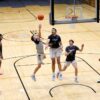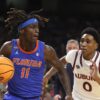In 2021, the NCAA supplied the 68 men’s tournament teams with squat racks, free weights, dumbbells; anything a team would need to play at a high level during a worldwide pandemic.
The women’s tournament, which wasn’t able to refer to itself as March Madness, was met with the bare minimum: a single rack of dumbbells and some sanitized yoga mats.
“When I came into college, we couldn’t even use that tag line,” USC graduate senior Talia Von Oelhoffen said.
The dumbbells, the yoga mats, and the lack of March Madness branding were the beginning of a change that would launch the women’s game to a level it hasn’t seen before. It was a change that would force the NCAA’s hand in providing women’s college basketball with the equality it deserved.
How it got to the point it’s at today was not easy, and it still isn’t easy for it to continue to grow.
The start of the climb
The 2021 season’s national championship totaled 4.1 million viewers. The next season, 4.9 million viewers tuned into the women’s national championship.
But the 2023 season, however, was different, as almost 10 million people watched LSU’s national championship victory over Iowa. The massive spike of viewers was in large part due to players like Iowa’s Caitlin Clark and LSU’s Angel Reese, two players who were advocates of growing the women’s game.
“You have to take that scary step of faith,” Reese said. “When I take those scary steps, I trust God and let him handle it.”
But as both Clark and Reese demanded a larger platform with both their advocacy and talent, the response was often adversarial. What was deemed normal competitiveness by Clark was sensationalized into Reese being accused of instigating conflict and showing poor sportsmanship.
This incorporeal dynamic perpetuated into their professional careers and detracted from the ways they both were bringing the sport a newfound status.
Women’s viewership surpasses the men’s
After an offseason full of both praise and criticism to both players, they met in the NCAA Tournament once again, this time in the Elite Eight. Iowa came away with a 94-87 win over LSU, and the game amassed a then-record 12.3 million viewers.
Clark and her Iowa Hawkeyes advanced all the way to the national title against South Carolina. Despite the Hawkeyes falling short to the Gamecocks, a new record was set, as the game averaged 18.7 million viewers and peaked at 24 million.
For the men’s 2024 tournament, the national title game between UConn and Purdue averaged 14.8 million viewers. Not only did the women’s ratings tower over the men’s for that season, but Iowa’s matchup with South Carolina was also the most-watched basketball game between men’s, women’s and college and professional, since 2019.
The 2025 season comes with new leaders
Women’s college basketball was coming off the most attention it’s ever seen going into the 2025 season. While Clark and Reese moved onto the WNBA, new leaders picked up where they left off.
Prior to the 2025 season, UConn’s Paige Bueckers announced that she would be returning for her fifth season with the program after a slew of injuries, including a torn ACL that kept her sidelined for her junior season.
“I believe everything happens for a reason,” Bueckers said. “Just being at this stage with my teammates, the coaching staff, in this UConn uniform, it’s what you work for during rehab, it’s what you work for going through the comeback.”
Bueckers came to UConn with more of a platform than arguably any incoming women’s college basketball player ever; a platform that came with high expectations.
But Bueckers used her platform to her advantage, and became a leader in the continued growth of women’s college basketball.
“It’s come a long way, even since my freshman year. The growth, the availability, viewership, people investing in women’s sports, it’s grown so much,” Bueckers said.
LSU’s Flau’jae Johnson and USC’s Juju Watkins both came to the collegiate level with similar platforms and expectations to Bueckers. The three became part of the next wave of leaders to continue the growth of the women’s game.
More leaders made themselves known through the transfer portal. Aneesah Morrow transferred to LSU for the 2024 season, but with talents to complement Reese and Reese’s move to the pros, Morrow’s platform only grew.
“For me to be at LSU, and do the things that I did every night, I’m just proud,” Morrow said. “Sometimes you have to look back on the accomplishments that you’ve had.”
In addition, Hailey Van Lith made the transfer from LSU to TCU for the 2025 season. With TCU looking to be a much better fit for Van Lith’s playstyle, the talent along with the platform that Van Lith went to Fort Worth with was expected to have that much more of an impact.
Stanford’s Kiki Iriafen, one of the top forwards in the country, transferred to USC for the 2025 season, and was set to play alongside Watkins and Von Oelhoffen, who transferred from Oregon State.
“The program, the people, I wanted to play with all the girls on this team,” Iriafen said. ‘I’m from Los Angeles, so I wanted to go back home. So the combination of winning and playing in front of my family is really what sold me.”
Virginia Tech’s Georgia Amoore, who LSU saw twice over the previous two seasons, including in the 2023 Final Four, transferred to Kentucky for her final collegiate season as one of the top guards in the country.
With Bueckers being healthy, Johnson and Watkins only continuing to grow their names, Morrow, Van Lith, Iriafen and Amoore making moves in the transfer portal and returners like LSU’s Mikaylah Williams, UConn’s Azzi Fudd and UCLA’s Lauren Betts set to make impacts, the 2025 season was set to be crucial for the women’s game.
The 2025 season shows consistency
Clark and Reese’s impact on the women’s game left immense shoes to fill when they both moved onto the professional level.
For the 2025 Final Four, the numbers weren’t quite what they were when Clark was playing in the Final Four. But they were, nonetheless, still monumental when it comes to where the game would stand in the post-Clark era.
The early Final Four matchup between South Carolina and Texas drew in 3.6 million viewers, while the UConn and UCLA matchup right after drew in 4.1 million viewers, peaking at 4.7 million.
After South Carolina and UConn punched their tickets to the national championship, South Carolina’s quest for back-to-back titles and UConn’s 12th national title in program history became the storyline. Not only that, but a storybook ending for Bueckers’ collegiate career was also on the line.
Just as she had all season, Bueckers manifested that fairy tale ending, which included three consecutive 30-plus point performances to advance to the Final Four.
Bueckers totaled 17 points, six rebounds, three assists and two blocks in a 82-59 lopsided victory for a National Championship. The storybook ending that was a dream became a reality, and Bueckers is now set to be the likely No. 1 overall pick in the upcoming WNBA Draft.
What’s next for the women’s game?
As the women’s game saw more and more players emerge themselves as leaders for the growth of the game, many of those leaders are set to return for the 2026 season.
For starters, Johnson is set to return for her senior season at LSU instead of declaring for the WNBA Draft. With Williams also returning along with a No. 1-ranked high school recruiting class coming to Baton Rouge, LSU looks to be a force once again in the women’s game.
“I’m honestly grateful to have the opportunity to come here to LSU,” Morrow said.
The same goes for UConn. Fudd announced that she’d be returning for her fifth season rather than going to the WNBA.
“I think knowing that I haven’t really had a full, healthy year here,” Fudd said. “Having one more year to work on myself, be a better leader, be a better teammate, grow in different areas of the game, have another year here under these great coaches with these great players before a go pro is what I need to be ready.”
But UConn also has a star set to return; a star that made herself known as a true freshman: Sarah Strong.
Strong averaged 16.4 points per game along with 8.9 rebounds per game in her first collegiate season. With back-to-back 20-plus point games, she led the Huskies with 24 points, 15 rebounds, five assists, two steals and three blocks for a program’s 12th title.
Watkins is set to make a comeback at USC after suffering a torn ACL in the Round of 32 in the NCAA Tournament. She was USC’s leading scorer with 23.9 points per game along with 6.8 rebounds per game, 3.4 assists per game and 2.2 steals per game.
Betts is set to return for UCLA after leading it to a Final Four. She saw a spike in her overall performance in the 2025 season, and is set to be a leader for the Bruins for the 2026 season.
“Growing up watching March Madness, it’s always something I’ve dreamt of being a part of,” Betts said. “I’m just really thankful.”
Olivia Miles sent shockwaves across the women’s game when she not only announced she’d be forgoing the WNBA Draft, but also that she’d be entering the transfer portal after four seasons at Notre Dame. She announced she’d be transferring to TCU, filling the shoes of Van Lith, who is set to move onto the pros.
In addition, Florida State’s Ta’Niya Latson, who LSU saw in the second round of the NCAA Tournament, announced she’d be transferring to South Carolina. Latson led the country in scoring with 25.2 points per game, and will be expected to have a hand in continuing a dynasty in Columbia.
“I’m just proud of myself,” Latson said. “I’ve grown a lot this season, and still have so much to learn and so much to grow from.”
Notre Dame’s Hannah Hidalgo and Texas’ Madison Booker are two more notable returners who are set to keep their respective programs in the national spotlight.
That’s a lot of names. But for the women’s game, that’s only a good thing. Just like the 2025 season, the leaders will only grow, and new players will emerge themselves.
The difference five seasons has made is drastic, and it only shows the village it took to get there.
Now, women’s college basketball and all its leaders certainly have lots more than just a stack of dumbbells and some yoga mats. And it will continue to gain so much more.
“[We] definitely deserve it, but I feel we have a long way to go,” Strong said.
This post was originally published on this site be sure to check out more of their content.








